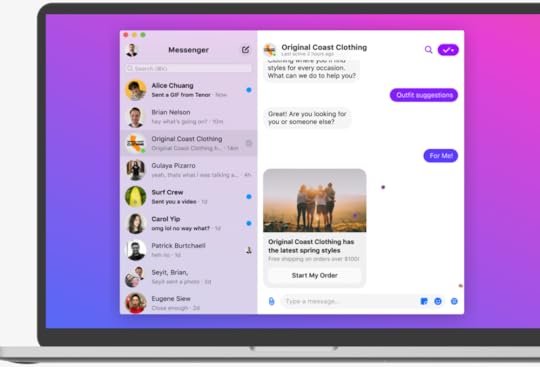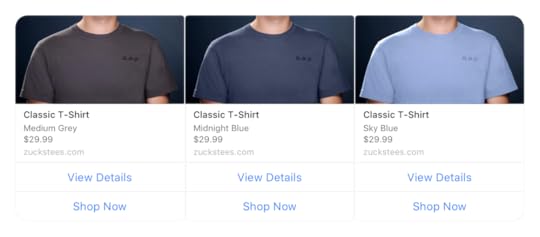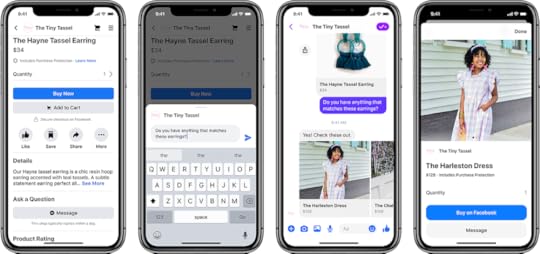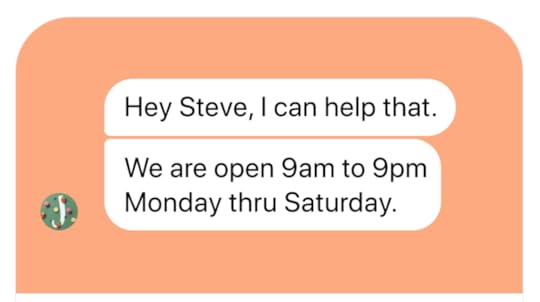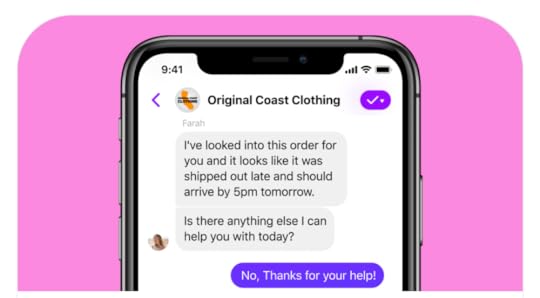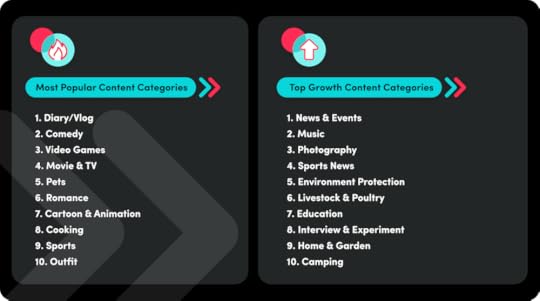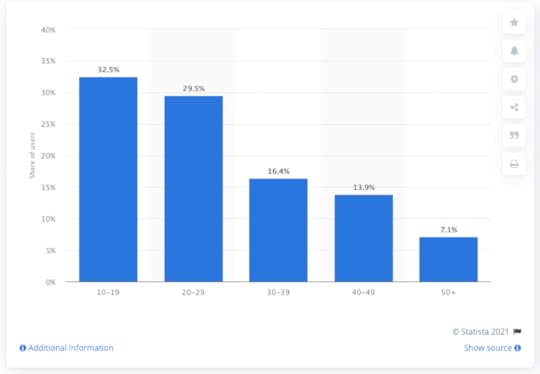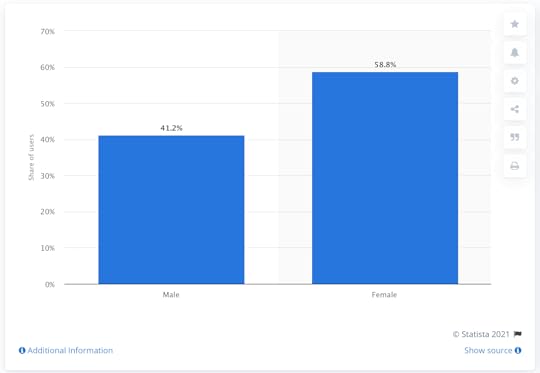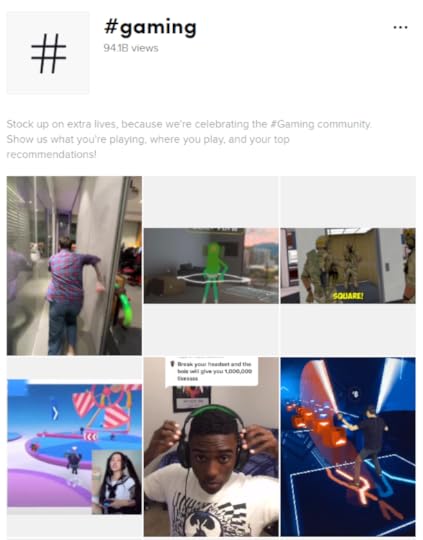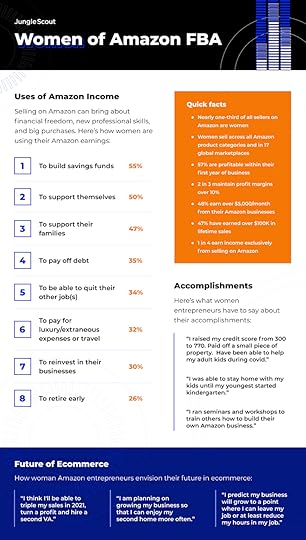Brian Meert's Blog, page 57
April 1, 2021
How to Excite Customers and Drive Sales with Messenger

APR. 2, 2021
Alexander Shatov / Unsplash
In the wake of the coronavirus, smart e-commerce business owners recognize the value of creating personalized online shopping experiences. And those companies can most definitely harness the power of Facebook Messenger to create a conversational shopping journey.
Source / Facebook
Using Facebook Messenger, brands can get closer to delivering an in-person experience – even if there’s no brick-and-mortar store for customers to walk into. And they can do that while still offering the convenience of online shopping. Customers get the best of both worlds.
Facebook Messenger does more than just offer a way to chat with customers, though. It also helps to streamline the buyer experience. Let’s get into the perks of using Messenger for e-commerce.
Lead GenerationBy adding a Send Message call-to-action (CTA) to your Facebook Page, you can show visitors that they can get in touch with you the way many modern customers like best: through chat. You’re also able to set up Facebook Ads that, when clicked, take the user to Messenger, where they can start a conversation with your brand.
If you want to add chat functionality to your website, you can do that, too. The Facebook chat plugin can go onto your site so that you can talk to customers there.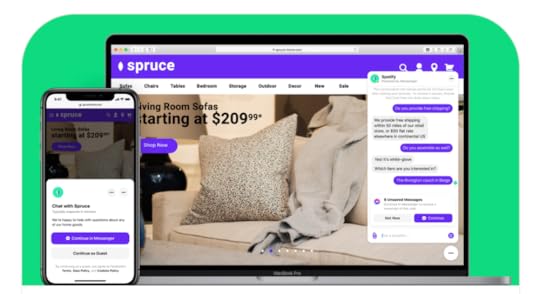
Source / Facebook
Here’s another option: Add a QR code to your brick-and-mortar store signage, your product’s packaging, or your direct mailers. When scanned with a smartphone, the QR code will take the user to a Facebook Messenger window, where they can start a conversation with you. You can also add hyperlinks to emails and social media posts that act in the same way.
Encouraging SalesMessenger has a lot of rich features tailor-made for e-commerce stores to help drive sales:
Integrate your product catalog (you can also use Facebook Shops to sell services, FYI)Send receipts and shipping updates to customersAlert customers when a product they have their eye on is back in stockAutomate FAQs so your human agents can be freed up to take on more pressing queries – and so customers get answers right awayHere’s something else to keep in mind: when an order is placed through Messenger, it can be routed to the correct department (like inventory management) so they can take over the process from there.
Also, payments can be taken directly through Messenger – you don’t have to make the customer leave Facebook, go to your website, check out, etc. Everything can be handled in the app.
Building Relationships and Establishing TrustWhen you use Messenger for your e-commerce store, you won’t just connect with a potential or current customer once and then forget about them. The channel allows you to follow-up and engage (and re-engage) with them on a steady basis so you can continue building trust and the customer-brand relationship.
Customers can ask questions about the products in your catalog and then place an order when they’re confident enough to move forward with the purchase. This means you’re able to get rid of a huge hurdle to buying, all through Messenger. That shortens the customer journey, speeding up both your sales and your customer’s satisfaction.
Source / Facebook
How to Get the Most Out of Facebook MessengerKnowing that Facebook Messenger can be used to drive sales and improve your relationships with your customers doesn’t mean you know how to use it best. In this section, we’ll cover the top must-know best practices so you can get the most out of Messenger.
Monitor Expectations When it Comes to Response TimesToday’s customers are accustomed to instant gratification. Case in point: you can order practically anything from Amazon and have it delivered within two days, max. The same is true for chat – customers want to be heard right now.
Realistically, that’s not always possible. So, when you’re not around to carry on the conversation, let customers know. You can have an auto-response set up that tells the user when your hours are so they know when (and when not to) expect to hear back from you.
Keep All Responses SuccinctFacebook may be a social media channel that’s heavy on peer-to-peer contact, but that doesn’t mean that a potential or current customer wants to get into a long-winded convo with a brand. When responding, stick to the point and write short sentences (while remaining friendly, of course). Don’t get too wordy – customers want to get in and get out.
Only Send High-Value MessagesThis tip is especially important when it comes to the automatic messages you can send when you’re not there to answer in-person. You want to make sure that anything you send is of high value. For example, sending users an alert that their product has shipped is a high-value message; sending an ambiguous “update” on their account – that doesn’t say anything has changed – is a low-value message.
You have to be careful when sending out messages of any kind (automatic or live) because if too many of them are low-value, the customer will start automatically ignoring them.
One way to ensure every message a customer receives is a high-value one is to let them pick the content they get. For example, after a customer places an order, you can confirm it, then ask if they’d like to receive shipping updates.
How Will You Implement Facebook Messenger?With Facebook Messenger, e-commerce brands have a modern way to connect with their customers – both current and (hopefully) future ones. By automating certain messages, like answers to FAQs, account updates, and standard after-hours responses, you can let Messenger take over some of the customer service must-dos for you. And the rest of the time, you can be present to speak one-on-one with your core audience.
Ready to explore more? Check out these four ways you can leverage Facebook Messenger ads .
March 30, 2021
TikTok Content Inspiration to Amplify Your 2021 Strategy
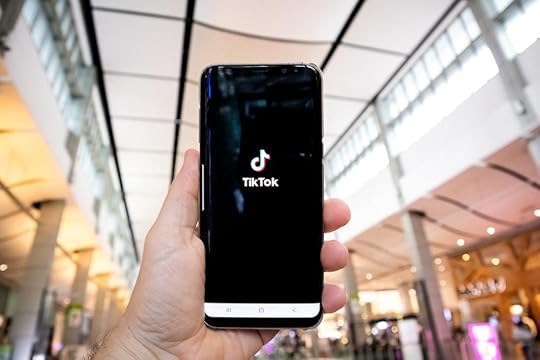
MAR. 31, 2021
Olivier Bergeron / Unsplash
TikTok is undeniably fun. Short videos from people of all ages and backgrounds, covering topics that range from cooking demos and life hacks to dance challenges and practical jokes? Sign us up.
(We’re not kidding about that variety, either. According to TikTok, the top global content categories cover everything from diary entries and pets to animation and environmental protection.)
Source / TikTok
But beyond that, TikTok is a marketing powerhouse for brands, namely those with an audience that is prevalent on the platform.
And who makes up that audience? A majority of TikTok users fall between the ages of 10 and 19 (so, if you have a brand that caters to older kids or teens, you should definitely be on there). The next largest age range is 20 to 29, so do not ignore those college kids or career-beginners, either.
Source / Statista
Plus, there is a somewhat-even split between male and female users, so regardless of which gender your brand markets to (if it leans one way or the other), your audience is present on TikTok.
Source / Statista
With that said, let’s jump into how brands can use TikTok for marketing, especially during a time of COVID and quarantine.
Turning Home Into a HavenWe’re all spending much more time at home than we used to, and the need to turn the home into a haven has grown exponentially. That’s why home and garden content, with a focus on the calming and therapeutic, has grown in popularity – and why any brand that sells products or services that go toward home renovations or refreshers should take advantage of this trend.
@targetCEO of aesthetic on a budget @wear.is.sam#fyp #target”♬ original sound – target
In this video from Target, user @wear.is.sam shows viewers how to style a TV console on a budget (this is perfect for Target’s core audience since the store is known for its low prices). In this one, home tip expert Chantel Mila shows users how to clean water bottles with odd shapes – and her video is set to a cool soundtrack, too.
The real learning lesson with these videos is that the outcome isn’t the whole appeal or even most of it. The process is what people are tuning in for. And on top of simply showing viewers how to do something, brands can take it a step further by offering a coupon code and linking to the items featured.
Getting Out of the House, Now or LaterOutdoor- and travel-inspired content is big on TikTok right now. But even if people aren’t ready to hit the road or board a plane just yet, they are interested in daydreaming about it. They’re ready to plan ahead for it, too, which is good news for travel-industry brands. By offering limited-time discounts on bookings (book now, go later), those companies can earn a bit even before travel gets back to normal.
Contiki posts travel content on their TikTok profile, making viewers catch the escapism bug. They don’t have to do much other than show how amazing different locales around the world are. Travel blogger Curious Pixie takes a different approach by sharing tips for travelers, like this video about places to avoid in London.
@thecuriouspixieDo you agree? #uk #london #travel #londontiktok #england #visitlondon #tiktoktravel #becauseimalondoner♬ original sound – Curious Pixie | Travel Blogger
Adventure and travel brands don’t have to only promote far-off places, though, especially knowing that a lot of people are still uncomfortable traveling. Exploring one’s hometown or places that are a car ride and day trip away will sit well with users, too. Hydro Flask’s TikTok content may be limited because they don’t post much, but it ranges from outdoor adventure (like hiking and skiing) to go-green inspiration. This goes with their product line since they make durable, insulated, reusable thermoses that are popular with outdoor enthusiasts.
Make Like a Kid and PlayGaming is an enormous niche on TikTok, and even if you’re not a video game brand per se, you can take a tip from the community and inject some fun into your content. You can create content in the vein of video games, like this one from user @thetimmy8, which was featured on the super-popular Gaming account. Or, you can gamify a portion of your app or website, then promote the new feature on TikTok.
And if you do have a video game-centric brand, you’re in major luck. The #gaming tag has 94 billion views, and has an impressive 48.3 billion. Plus, industry-related brands don’t have to create video games, necessarily. If you sell some sort of tech, like computers, TVs, or even headphones, you can get involved in the gamer community. Heck, even comfy clothing can be marketed to appeal specifically to gamers.
Final Thoughts: The Future (as Informed by the Past)There were some trends in 2020 that have held through into 2021, and it seems that they’re here to stay (temporarily, at least). Many of them have to do with the effects of COVID and how just about everyone was forced into lockdown. At-home content skyrocketed, like cooking how-tos and connecting-with-nature videos (think: camping). Even more 2020-specific content growth occurred in the following categories:
News and eventsMoviesMusicTV showsVideo gamesThink outside the box when it comes to the trends covered in this article, too. You may have to re-think how your brand can serve people in the home instead of outside of it or how your products can be used during travel when they used to be meant for a work commute. We’re not suggesting you force a connection that isn’t there, just that you adapt if possible.
Convinced that your brand needs to be on TikTok? Competition is limited right now because brands are just starting to catch on to how powerful a marketing platform it can be. If you look up some of the biggest brands in the world on TikTok, many of their profiles are bare, which means there’s a major opportunity for you to catch the eye of potential customers.
When you’re ready to get started, check out our article about how to make a TikTok video .
March 28, 2021
How Women Are Winning on Amazon [Infographic]

MAR. 29, 2021
William Fortunado / Pexels
It’s a proven fact that anyone can sell products on Amazon. Whether you’re young or old, have a Ph.D. or a GED, or are a busy working parent, you can find success as an e-commerce entrepreneur.
Despite this breadth of opportunity, just 32 percent of Amazon sellers are women. And while Jungle Scout’s annual survey of Amazon sellers shows that his figure has risen from 26 percent in 2020, there’s still considerable ground to cover in terms of equal gender representation in e-commerce.
The good news is that what women lack in numbers, they make up for in performance as Amazon sellers.
The vast majority (85 percent) of women who run Amazon businesses are profitable, 57 percent have become so within a year of launching their businesses. That’s no small feat, considering that 39 percent of women sellers also work jobs unrelated to their Amazon businesses (another 27 percent are self-employed or own a business). On top of that, more than three-quarters run their businesses out of their homes, where—as many of us have experienced over the past year—it can be difficult to find time and space to learn a new trade.
But these entrepreneurs persevere: about half of all women selling on Amazon earn an impressive $5,000 or more in sales each month. One in five women have made over six figures in lifetime profits on Amazon, and 8 percent have become millionaires through their Amazon businesses.
The Impact of COVID-19 on Amazon SalesTo a large extent, women have been able to maintain the success of their businesses throughout the COVID-19 pandemic: despite supply-chain slowdowns and other restrictions, 64 percent saw higher profits in 2020, and 47 percent say their business performed better because of the pandemic.
Like many entrepreneurs, the women of Amazon began their e-commerce businesses for the flexibility remote work offers, to be their own bosses, and to feel challenged and accomplished in their careers. With earnings from Amazon, women have been able to build personal savings, pay off debt, and even quit their primary jobs.
Selling has also yielded opportunities to build soft skills, earn promotions at work, and achieve a work-life balance. Here’s what some women have said about what they’ve gained from their experience as sellers:
“I’ve been able to run my own business and have more freedom to schedule my day. I’m starting to earn enough money to live comfortably.”“A feeling of success.”“Professional achievement. I became the Amazon Team’s manager at the company I work for.”“Created a strong community that collaborates on how to improve the business. Got out of my comfort zone.”What the Future Holds for Women of AmazonWomen are looking ahead to further growth in 2021 and beyond. Already, one in four earn income exclusively from selling on Amazon, and one in five have hired an employee or two to help run their businesses. Over a third are considering expanding their operations to Walmart.com this year.
While it’s no surprise that women have found success through Amazon entrepreneurship, their accomplishments are impressive nonetheless. As online shopping continues to grow worldwide, it will be interesting to see how many more women launch Amazon businesses and whether e-commerce can continue to open leadership opportunities for women in business.
To learn how to launch an e-commerce business, check out our step-by-step guide to selling on Amazon.
You can find more information about Amazon seller demographics here.
By Molly Burke, Content Specialist at Jungle Scout
March 24, 2021
Updates Announced for Facebook Partner Directory

MAR. 24, 2021

Will Francis / Unsplash
Facebook announced several key improvements to the Facebook Partner Directory in an email on Monday.
The changes are effective immediately and aim to make it easier for advertisers to connect with Facebook Marketing Partners.
Perhaps most notably, partner profiles will no longer display “Badged for [program].” Instead they will include a list of supported solutions corresponding to their badge. For example, for Commerce Partners it will list “Sell on Facebook” as a solution type.
The most valuable features announced also include a new design for search, a responsive layout and the removal of the “budget” filter.
According to an email sent out to all Facebook Marketing Partners, the changes will include:
New design for search and profile pagesSearch requirement to select a solution type before adding any additional filtersNew selector tool to view bookmarked partnersNew responsive layout for a better mobile experienceIntroducing a new beta program for WhatsApp Business Solution Providers (BSPs). This helps qualified WhatsApp BSPs to remain in the directory.Partner profiles will no longer display “Badged for [program]” language. Profiles will now display a list of supported solution types that correspond to their badge– such as “Sell on Facebook” for Commerce partners – under the partner’s name.Removal of “budget filter” as part of the search options. However, the budget range still remains visible on partner profiles.March 19, 2021
The 10 Best Facebook Marketing Books That’ll Help Improve Your Ad Results

MAR. 19, 2021

Austin Distel / Unsplash
In 2021, it goes without saying that you simply need Facebook as part of your digital marketing strategy. But there’s a huge learning curve when it comes to running Facebook ads. Luckily, there are numerous books out there to help. Here are our favorites.
Ultimate Guide to Facebook Advertising by Perry Marshall, Keith Krance, and Thomas Meloche
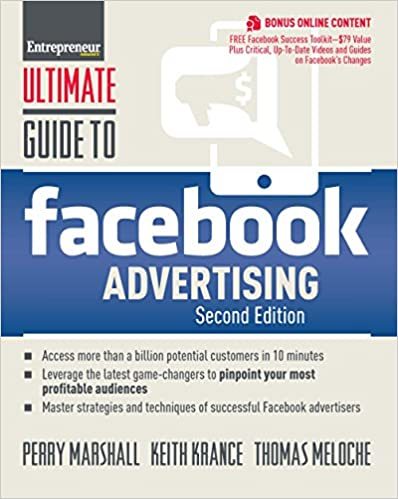
This ultimate guide will teach you about both direct marketing with Facebook and how to use the platform in general. If you need an overall Facebook how-to for business, pick this book up.
Promising Review: “I got this book as I was already familiar with one of the authors through his [podcast] – and truly glad I made the investment. There is so much changing in FB marketing – and so much that is still new to most of us. These guys have your back and will help you keep up on the stuff to come.”
The Complete Guide to Facebook Advertising by Brian Meert
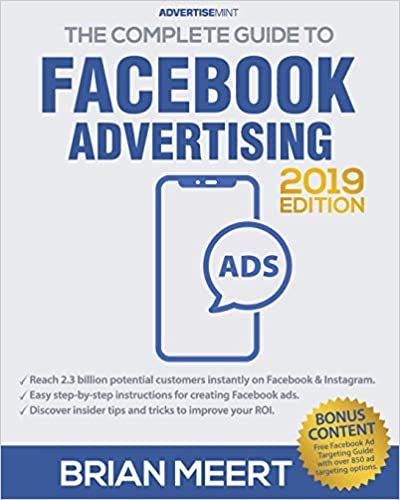
This book will help you reach 2 billion potential customers across Facebook and Instagram through its suggested advertising strategies. Plus, there are insider tips from Facebook pro (and the author of the book) Brian Meert that you won’t find anywhere else.
Promising Review: “Awesome book on Facebook advertising! I love love love the fact that this book is printed on demand and will be updated as Facebook changes so that the information is always current, no matter when you purchase the book! I have never seen that before! This book also has really great step-by-step instructions for creating your ads, with pictures so you’re never confused! I’m so glad I have this book and will recommend it to every business owner I know!”
500 Social Media Marketing Tips by Andrew Macarthy
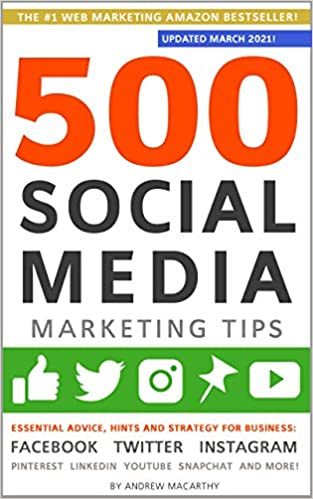
If Facebook is just part of your digital marketing strategy, and you’re using other social platforms as well, these marketing tips will give you well-rounded advice in bite-sized morsels.
Promising Review: “As a brand new business owner, I knew social media needed to play a big part in my marketing strategy. I’m the average Facebook user, casual Snapchatter, and complete novice at Instagram and Twitter. A person could easily read this book in a few hours, but I found I wanted to constantly pause to take notes. I also found myself compelled to share the info with friends who are small business owners. Immediately I found the tips in this book to yield results. I honestly couldn’t [recommend] it higher to anyone new to using social media as a marketing tool.”
The Beginner’s Guide to Facebook Advertising by Jessica Ainsworth
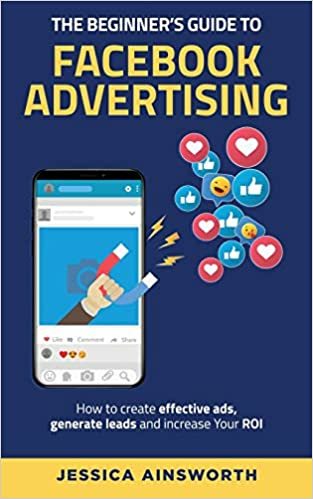
If you’re a total newbie to the world of Facebook advertising, this book will hold your hand as you take your first (and next) steps. It’s a quick read, too, so if you need to expand your Facebook marketing knowledge ASAP, you can emerge that much smarter after an afternoon.
Promising Review: “This is THE BOOK for you if you, like me, were clueless about Facebook ads! I knew I wanted to use Facebook ads but had no idea where to start. I love how this book not only walks you through everything you need to know about Facebook ads but also has great information [that] any entrepreneur can benefit from, like really drilling into your target audience and how to identify them and use Facebook ads to target that audience – as well as differences between a Facebook page and group. The information is laid out simply but with all the right detail. I highly recommend this book!”
Facebook Marketing Step-by-Step by Bryan Bren
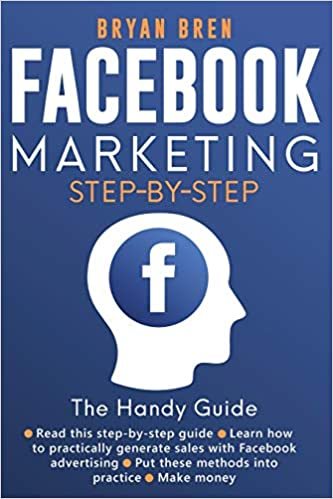
Running Facebook ads isn’t worth much unless you’ve honed in on your target audience. In this book, you’ll learn how to do just that, along with getting a step-by-step guide on how to set up, manage and learn from your Facebook ads. You’ll also explore engaging marketing strategies, like running contests.
Promising Review: “What a great resource full of valuable information and followed up by an automated series of emails. Highly recommend this book to anyone interested in FB advertising tips and techniques.”
Social Media Marketing Workbook by Jason McDonald 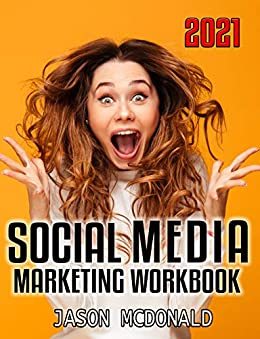
Don’t think that you have to do all the work when it comes to this book – while it does have workbook components, it’s also jam-packed with information about social media marketing, Facebook included.
Promising Review: “As a business owner who has not had to bother too much with social media up to now and who was beginning to feel left behind, I have to say a great big ‘thank you’ to Jason. Your book is easy to read and digest. And the support materials you offer to registered users are amazing. In less [than] a week, I have identified my best social media options and a plan is in development. A social media cloud has been lifted. It’s going to be hard work to get to where I want to be. But this book will always be there for me to dip into. Thanks again!”
More Books We Think You’ll LoveDon’t miss these must-reads, either:
Facebook Marketing for Dummies by Stephanie Diamond and John HyadonFacebook Marketing: World Class Strategies for Optimizing Your Page, Getting Lots of Likes and Creating Compelling Facebook Ads That Product Powerful Results by Susan HollisterFacebook Ads Made Simple: How to Create High-Converting Facebook Ads in an Hour or Less by Andrea VahlThe End of Marketing: Humanizing Your Brand in the Age of Social Media and AI by Carlos GilSince your Facebook marketing education is never truly over, we think you’ll get a lot of help from our Complete Guide to Facebook Ad Targeting.
March 17, 2021
6 Tips to Keep in Mind Before Selling Your Products on Amazon
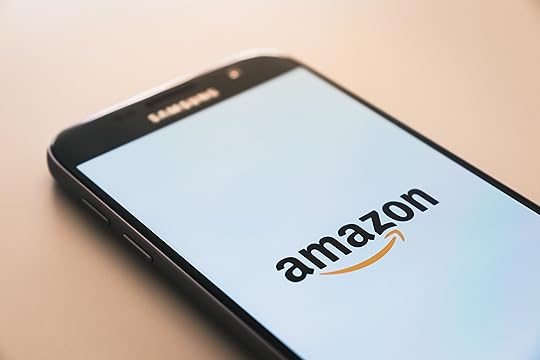
MAR. 17, 2021
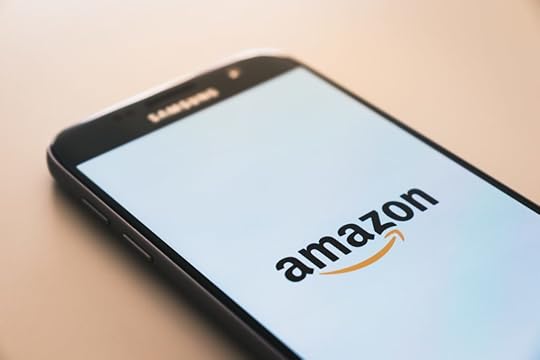
Amazon is an ideal marketplace for sellers who want to make money from their products and tap into a large audience without having to build it from scratch. There’s a lot that goes into selling on Amazon, though, and while they have a ton of guidance for beginners, you can never know too much – especially when it comes to gaining happy customers and earning money.
Decide What to SellThis may seem obvious, but some sellers know that they want to sell on Amazon without being too concerned about what they’ll sell. But even though Amazon has an enormous user base, it’s not a surefire way to make money. In order to be a successful seller, you have to carefully choose the products you list, avoiding anything that’s too offbeat or too popular.
Why? You’re going to have a difficult time selling either type of product. Items that are interesting to you but that aren’t in demand by customers are going to be nearly impossible to rank and sell. On the other hand, items that are incredibly popular are going to have too much competition. The sweet spot is sticking to products among the top 1,000 bestsellers on Amazon without going for the ones that countless other shops have listed.
Get Ready to Check Orders Every DayBefore you start selling on Amazon, make sure you’re up for the task. Possibly the biggest commitment is checking for and fulfilling orders daily. If you use the FBA (Fulfillment by Amazon) service, this becomes easier, but you’ll still have to stay on top of the orders and customer contact you receive. You should get an email from Amazon when an order comes through, and you can also sign up for text messages, but it’s most reliable to check the Seller Central dashboard daily in case you miss something.
Consider Using FBASpeaking of FBA, put some thought into whether or not you’re going to use it. FBA stores your inventory, packs and ships orders, and also handles returns. This, of course, costs money, but what you end up saving is time (and headaches). If you’re at all worried that you won’t be able to manage your inventory and/or shipping responsibilities, let Amazon handle it all for you.
Bonus: Buyers will be treated to faster delivery, which means a better chance of getting positive reviews. And shining reviews are what help your products rank higher while encouraging other potential customers to go through with a purchase.
Be Prepared to Adjust PricingAs an Amazon seller, it’s imperative that you have a flexible pricing strategy in order to stay competitive. There are a few different ways to do this:
Manually reprice items as competition changes. This is a fine strategy if you have a small number of items because it’s easy to track the competition and make pricing changes manually.Rule-based repricing is an automated way of having your products’ prices updated. After setting predefined rules for how and when prices will be adjusted, they’ll be changed according to how the competition is pricing their products. Ultimately, the idea here is to have the lowest price.Algorithmic pricing is another automated pricing strategy. This one, however, using algorithms that take into account not just on-Amazon competition, but a variety of other market conditions.Whichever method you choose, know this: Amazon pricing is not a set-it-and-forget-it task. You’ll need to update pricing regularly if you want to continue selling.
Understand the Buy BoxYou already know this, but Amazon allows multiple sellers to list the same product (which is why competitive pricing is so important). All of those sellers aren’t just competing for customers, though – they’re also competing for the Buy Box for a particular product. When a customer looks up an item on Amazon, the Buy Box is located in the same area where they add the product to their cart.
When a seller “wins” the Amazon Buy Box, that means that they become the default seller for that item. Clearly, this means you’ll (likely) make more sales than other sellers.
It’s not entirely certain how Amazon chooses which seller to list in the Buy Box, but there are a few ways to increase your chances of winning it:
Make sure your bestselling items are always in stock and that the inventory is updated in your Seller Central.Price your products competitively – the Buy Box usually lists the lowest-priced item.Offer various shipping options and speeds, and consider offering free shipping.Stay on top of customer service – Amazon probably picks Buy Box sellers with good Account Health (which you can find in the Performance area of your portal).Even if you nail each one of these tips, that’s not a guarantee you’ll win the Buy Box for every (or any) product, but they do put you in a much better position to.
Take High-Quality Photos of Your ProductsIt’s pointless to set up your Amazon products before you have quality images of them. Product photos have a major impact on buying decisions. On top of sticking to Amazon’s image guidelines, you want to make sure you’re taking high-def photos, shooting your product in a variety of ways and placing it against a white background so nothing distracts from the subject. On top of the main image, which must be just your product on a plain, white background, consider adding lifestyle photos and even an infographic if it’ll help explain how to use it.
Wrapping UpThere are a lot of different elements to effectively selling on Amazon. But getting as prepared as possible ahead of time will make it easier to manage the must-do tasks once you actually start listing and selling your products. And once you do get your products up and your shop live, there’s plenty of advice to help you master your new role as an Amazon seller.
March 15, 2021
Copywriting Tips For High Performing, High Conversion Video

MAR. 15, 2021

Thirdman / Pexels
Over half of today’s consumers want to see videos from brands they associate with, and a tremendous 87% of marketers reported a positive ROI from their videos. This makes video one of the most lucrative forms of content marketing in 2021.
Now that you know the benefits video can bring to your marketing strategy, ever wonder the secret to a killer video? Before you can even think about capturing the flashy camera shots, aesthetic b-rolls, and innovative video effects that you wish to use, you’ll need a well-written script to keep your video organized. This is because scripts are the backbone of any video. They possess helpful lines and cues that ensure you don’t stray from the overarching story that you hope to tell.
A well-written script will solidify a clear pathway for your video’s journey, correlate your lines with coinciding camera shots, cues, and angles, and help your actor avoid rambling and filler words
Since scripts are primarily composed of the lines you will read on-screen or as audio narration, having solid writing skills will come in handy. Whether you’re writing your first script or a seasoned pro, here are five copywriting tips for video scripts that will tell your brand’s story in the best light.
1. Write As You SpeakThough written on paper, scripts are always meant to be read aloud and should be written with conversational and natural copy. It is important to always keep this reminder at the forefront of your mind, as it can be easy to forget when you are deep in the thickets of the writing process.
To avoid the dreaded reading-off-a-script feeling, make sure to practice reading your script aloud a lot to ensure that it flows naturally from your mouth and represents that tone of your brand. Also, avoid any cliché phrases or buzzwords that you know you wouldn’t say in conversation with your consumers if they were sitting right across from you
2. Stay Focused on Your End GoalVideos should serve a clear purpose in your marketing strategy: to educate, inspire, and assist consumers with a pain point or need. The copy that makes it into your script should always go back to the original goal and intent of your video. When writing your script, it is helpful to check in with each line by asking yourself
Will this sentence propel the message of my story forward?Is this piece of information essential for my viewers to hear? What fluff or filler words can be scratched to make things more focused?It is also important to pinpoint the stage of the sales funnel your consumers are in. If they’re at the top of the funnel, your video script’s goal won’t be as focused on making a sale as a script that is meant for consumers at the bottom of the funnel.
3. Make a Strong First ImpressionDue to our dwindling attention spans, you don’t have much time to get your point across to audiences. In fact, studies found that you have only around 10 seconds to grab your viewers’ attention. This means that your copy should intrigue consumers right out of the gate. Some ideas for hooking viewers from the start include:
Outlining who you are and what you care about as a brandPromising a story, surprise, or benefit that will accompany the video Presenting a problem or pain point that your video will address and solve 4. Tell a Powerful StoryCompelling copy has the power to transform your video into more than just a piece of marketing content — it can help your script tell a story. Simply put, a story has the ability to connect with the hearts of your consumers. It reminds them that you are so much more than just a brand selling a product — you are a unique team of individuals with shared values and beliefs.
Storytelling can be accomplished by staying authentic to who your brand really is. Don’t be afraid to entertain audiences through playful humor and glimpses into your personality. You can also use copy to elicit an emotional response from your audiences and create a clear story arch by outlining a solid beginning, middle, and end of your script.
Video marketing is here to stay, and for good reason! Videos are undoubtedly more eye-catching and attention grabbing than other forms of content, so much so that it has 12 times more shares than both written text and photos. You don’t have to be a career copywriter to implement these strategies. Put these tips into action and put yourself in a position to execute the best marketing video possible!
By Liz Slyman
March 11, 2021
5 Critical Steps to Planning a Powerful Content Marketing Process

MAR. 11, 2021
Effective content marketing can result in many benefits, including increased visibility, traffic to your site, and conversions. It can also help build credibility and trust while strengthening your recognition as a brand.
However, sometimes in the race to have content published regularly, marketers forget other crucial content marketing aspects. They forget that quality rather than quantity is the key. Furthermore, there is no need to create content only to meet a publishing schedule. Instead, your aim should be to create content that offers your customers and business value. But how can you, as a marketer, achieve this? You need a content marketing process. It’s a plan that guides you from content ideation to results measurement and optimization.
Let’s look at the essential questions you should ask yourself before creating a content marketing process.
What Outcomes Do You Want from the Content?Do you want to drive traffic to your site, increase conversions, grow your authority on a topic, or something else? Your content marketing needs a purpose, clear goals that you can work toward achieving and metrics that help you track your performance.
Who Are Your Customers?To understand your ideal buyer, conduct research to help you determine
The content that resonates with themTheir interests and needsTheir demographicsThe information they search forThe devices do they useThese questions can help you understand your ideal buyer. Then you can find ways to structure your content in a way that will engage and drive them to action.
How Should You Scale Content?Your content marketing process needs to be flexible enough to meet the ever-changing customer and market demands. To do this, establish an efficient workflow that helps you produce content fast, and this entails researching high-value, well-performing keywords; writing engaging content that offers value, and marketing and promoting what you write. This brings us to the next question:
What Channels Should You Use to Distribute and Promote Content?If you don’t distribute and promote your content, no one but your team will see it. There are many options, including blogs, email marketing, social media, third-party distribution channels, pay-per-click, etc. However, your choice of channels should depend on your audience and how they seek information.
How Do You Measure Success?You can use tools such as Google Analytics or social media analytic tools to determine if your content helped you meet goals. Tracking metrics can also help identify the kind of content that works, the channels that perform better, and areas needing improvement.
But now that you have all this information at hand, how do you structure your content marketing process? The infographic below includes an easy five-step process you can leverage when structuring your content marketing process. Check it out!

March 9, 2021
How to Build a Strong Instagram in 2021 and Beyond

MAR. 9, 2021

Pixabay / Pexels
How happy are you with your brand’s Instagram account? Do you have the number of followers, engagement rate, reach, and conversions you’re after? Or are you lagging behind your competition, always trying to catch up to the latest trends?
If you find yourself in the second category, it might be time to adjust your strategy. After all, with a global tendency towards increased screen time, 2021 could be the perfect year to get the most out of your Instagram tactics. If you build a strong community on the platform, you might just see all your efforts finally starting to pay off.
But what can you do to achieve your desired results? Here are the tips for strengthening your brand through one of the most popular social media platforms in the world.
Go Back to BasicsThere’s no denying that businesses need to be on Instagram, especially if they want to reach users between the ages of 18 to 34 who have a strong tendency towards logging in more than once per day. But the thing is, creating a profile and posting regularly isn’t enough. For a brand to be able to make data-based decisions, they need to have the right insights. That’s impossible without properly setting up their profile.
That’s why one of the must-dos for 2021 will be changing to a business account on the platform. In addition to insights, this will allow you to:
see your follower demographicsadvertise your posts and storiesset up an online shopadd actionable CTAs to your contentadd clickable contact information to your profileautomate processesuse third-party apps to schedule postsMake Instagram a Key Part of Your Digital StrategyAccording to a Facebook report, after seeing a product or service on Instagram:
79% of users sought more information65% visited the brand’s site or app46% made a purchase37% visited a physical location31% followed the brand online29% mentioned the brand to someoneLooking at this data, it becomes clear that the potential of the social media platform is huge. It’s not just a way to get closer to buyers, but Instagram can play a crucial role in SEO and sales as well. So, what can business leaders do to use the social media platform’s full potential?
Well, for one, they can utilize it in a way that will drive traffic to their website. For example, a post or Story can be a great way to preview and link to a blog, e-commerce store item, or a relevant piece of content. This is what Tasty does in their Stories sections, with short video previews that feature interactive poll stickers and lead users to long-form content posted on platforms like YouTube.

@buzzfeedtasty / Instagram
Alternatively, Instagram can be a great way to support a variety of marketing campaigns. For example, Transparent Labs created a nine-week online event to help their audience build healthy habits by issuing a weekly challenge. Then, they encouraged users to share their progress through social media, offering prizes and discount codes in return.
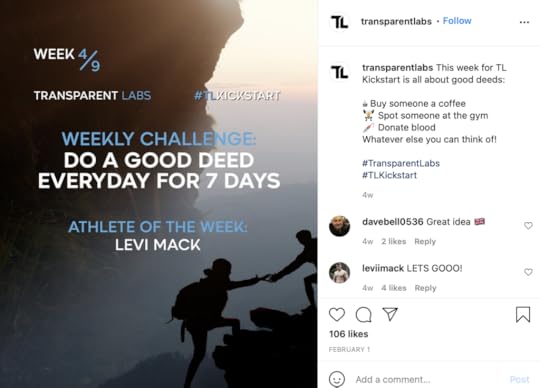
@transparentlabs / Instagram
The great thing behind such a campaign is that it accommodates several goals at once. It helps the company with lead generation, boosts website traffic, increases social media following, encourages engagement and UGC, and offers the opportunity to give back to fans, increasing loyalty and customer satisfaction.
Use All the Available FormatsInstagram started as a social media platform that primarily focused on sharing images. However, in 2021, it’s much more than being just that. Today, it is a multimedia space that lends itself to a wide variety of formats and applications, making it the perfect distribution network for high-quality, engaging content. So how do you make the absolute most of it?
In addition to practicing consistency and cohesion, brands need to look for ways to make their Instagram posts attract interest, build consumer trust and loyalty, drive engagement, and, ultimately, generate sales. And that means investing in content that’s likely to attract attention.
For one, the must-follow strategy for making the most of Instagram is to use Stories and to do so often. According to the platform itself, there are more than 500 million daily Stories users. One-third of the most-viewed Stories come from brands. And, the reply rate for the format is 20%, an impressive statistic in itself.
But what makes a great Story? Well, it turns out that users have a strong preference for posts that actually tell a story. So, try to find ways to serve them content that they’ll find entertaining, educational, or valuable.
A brand that’s doing a great job with its strategy is Cat & Cloud, a California-based business that runs several coffee shops. What’s interesting about this brand is that they’ve decided to skip the purely aesthetic approach as is common in its industry. Instead, the brand produces a podcast and uses the Instagram Story feature to share it with its 39k followers.

@catcloudcoffee / Instagram
As for the content that stays around for more than 24 hours, research shows that the carousel format is the most worth investing in. According to Socialinsider, the average engagement rate for carousels is 1.92%. Images fall at 1.74% and videos at 1.45%. What’s more, the numbers go even higher with posts that use all ten slides or combine images with videos.
Finally, if you’re thinking about getting started with IGTV, 2021 may not be the perfect moment to do so. In 2020, this format displayed the highest decline in engagement rates – a whopping 75.6%. Unless you’ve got a really great idea for making use of the media type, you may be getting a higher ROI on Facebook or YouTube.
Focus on the Right ThingsThere are several misconceptions about Instagram for business. A common one is that you need to spend a lot of money if you want great results. But that’s not necessarily the truth. Research conducted in 2020 shows that the COVID-19 pandemic caused a significant shift in the way consumers interact with brands. A McKinsey report shows that, in the past year, most people chose to spend money on essentials and items of value, while the Edelman Barometer reveals just how impactful brand trust has become.
But what does this mean for social media marketing? For one, it’s a strong indicator of what today’s buyers are after. (Hint: it’s not flashy advertising.) In 2021, social media users will want to create bonds with brands. Not only will they have positive reactions towards companies that inspire trust, but moreover, they’re likely to make their buying decisions based on a brand’s purpose and mission.
Moving forward in 2021, brands can use Instagram to promote a higher level of transparency. Using features such as Live Videos, Stories, and Carousels, companies can offer plentiful information, behind-the-scenes looks, and interesting insights
Moreover, they can engage in genuine interactions with followers and fellow brands and start conversations using Polls, Questions, and similar stickers. Skincare brand Naturium, for example, allows followers to submit questions, then shares answers and tips provided by experts.
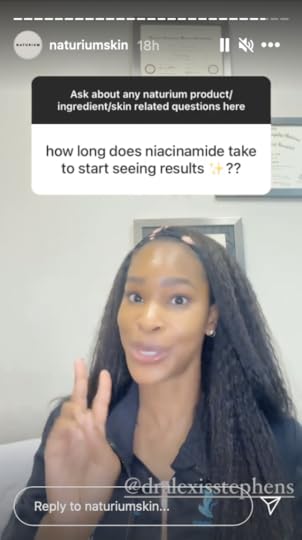
@naturiumskin / Instagram
Another excellent way to use the platform to drive connection and trust is to make it a space for collaboration. For instance, paddle board manufacturer GILI regularly shares user-generated content and even invites adventurers to send in their snaps using a dedicated hashtag.

@gilisports / Instagram
Although their following is still small, it’s a highly engaged group of watersports enthusiasts with whom they have built genuine relationships. Plus, it shows just how much you can do by working with micro-influencers and a limited social media marketing budget.
Alternatively, brands can use Instagram to strengthen community ties by supporting local artists, small businesses, NGOs, or followers themselves. No better example of this comes to mind than We Rate Dogs. An account that initially started off as a way to admire cute pups, it turned into a powerful platform for helping animals get the highest chance for a healthy and happy life, with a loyal following of almost 2 million fans.

@weratedogs / Instagram
The Future of Instagram
There’s no denying that social media apps are powerful tools brands can use to drive their business forward. And the fact is, they’re rapidly transforming into irreplaceable marketing and sales channels that are continuing to grow.
Nonetheless, business leaders and marketers must remember that the one thing keeping these platforms relevant isn’t their technical capacity. Rather, it’s their appeal to audiences who are tired of traditional consumer-brand relationships and want to be considered more than just a way to monetize products.
With this in mind, it becomes clear that the true potential of Instagram (or any other social media app) lies in its ability to build connections, communicate with, and grow closer to audiences. Because, ultimately, with such an approach, companies can get something much more valuable than a marketing channel. They can get immediate, unfiltered consumer feedback, helping them grow into an irreplaceable part of their customers’ lives.
March 4, 2021
Amazon or Shopify: Which Is Right for Your Business?

FEB. 4, 2021

Roberto Cortese / Unsplash
Both Amazon and Shopify are incredibly popular choices when it comes to selling online. Shopify estimates that it has 820,000 merchants using its software for their stores, while Amazon has more than 2.5 million active sellers. This makes them two of the top three methods of selling online.
That said, while both are great choices to sell with, deciding which is the best for your business can be tricky. That’s where this guide comes into play. It helps you evaluate the pros and cons of both Amazon and Shopify, as well as discover which is right for your business.
What Are Amazon and Shopify?Amazon is a marketplace, which allows you to list and sell all of your products on the site, competing against many other brands. Amazon will manage the majority of the ordering process for you, and if you use FBA (fulfillment by Amazon), the platform will even take care of shipping your products, too. With Amazon, setting up and selling is a simplistic process. All you need is an account and products, and you’re pretty much ready to go.
Shopify is a store-building software that allows you to personalize and construct your online store as you choose. Setting up a store using Shopify can be a little more time-consuming than with Amazon, but you do get the freedom to roam in terms of creativity. As your Shopify store will be standalone, you don’t have to worry about things such as on-site competition. However, you do need to direct traffic to your store by yourself.
The Pros and Cons of Selling on ShopifyAs Shopify is well established in the market, you can expect plenty of available features when building your store on the platform. But those features are just some of the perks. Here are some of the main benefits of selling on Shopify:
An extensive 90-day free trialFlexibility in store design and expansionA range of prices for all store sizesOwnership and control of your storeEase of useMobile friendlyAvailable multiple languages24/7 customer serviceAn e-commerce university to build business skillsIn contrast, here are the disadvantages of selling on Shopify:
You will all of your own marketing.You will build traffic from scratch.Some add-ons can cost you extra.You don’t have an existing brand reputation to get you off the ground.Some features are unavailable on cheaper plans.If you use a third-party payment provider, you will be charged transaction fees.As you expand, costs will also increase significantly for a Shopify plan and for marketing.The Pros and Cons of Selling on AmazonAs a pre-existing selling platform, some of Amazon’s benefits are there for all to see. But let’s take a look at some of the benefits of Amazon:
Little to no experience required30-day free trial of Amazon proAccess to a worldwide audience without any marketingPiggybacking off Amazon’s brand reputationEasy setup and useEasy customer service, refunds, and returnsFulfillment by Amazon for storage and deliveryRepeat customers because of the platform’s trustworthy reputationIn contrast, here are some of the disadvantages of Amazon:
High fees for selling on the platformTighter rules and regulations for listingsA lot of competitionPrice monitoring to remain competitiveMinimal personalization of your storeThe Costs of Selling on ShopifyShopify is a well established brand in the shopping market and therefore has varied plans depending on the individual seller’s needs. The plans cost between $29 and $299 a month, with transaction fees on top of that. Here are Shopify’s available plans in more detail.
Basic Shopify planBasic Shopify costs just $29 a month, but as the name suggests, it only includes the bones of Shopify. You will also pay 2% transaction fees on any sales that do not use Shopify payment, as well as additional fees for credit or debit card usage. The plan includes a shipping discount of up to 64%, offering you your own online store, with features such as
Unlimited products listingsA blogTwo administrative accountsManual order creationAn SSL certificateGift cardsAbandoned cart recoveryFraud Analysis24/7 customer supportDiscount codesHardware supportPOS LiteShopify Standard PlanShopify’s standard plan and costs $79 a month, plus 1% transaction fees on all sales that don’t use Shopify’s payment system. You will also pay additional fees for credit or debit card payments. This plan includes a shipping discount of up to 72%, as well as your own online store, and these features:
Everything included in the basic planThree extra staff administrative staff accounts, five in totalReportsManual foreign exchange ratesInternational domainsAdvanced Shopify planAt $299 a month, this is by far Shopify’s priciest and most extensive plan. On top of the monthly fee, you must also pay a 5% transaction fee on any sales that do not use Shopify payment, plus credit or debit card fees. The plan includes a shipping discount of up to 74%, plus your own online store, and these features:
Everything included in the standard plan15 staff administrative accountsAdvanced report builderThird-party calculated shipping ratesThe Costs of Selling on AmazonThere are a number of factors at play that decide how much it will cost you to sell on Amazon, which includes your location and domain of choice (for example, USA and Amazon.com or UK and Amazon.co.uk), whether you sell on an individual plan or a professional plan, and whether you use FBA (fulfillment by Amazon).For this guide, the focus will be on sellers in the United States and Amazon.com.
Individual SellersThe cost per sale for individual sellers is $0.99, plus a percentage for referral fees. You can also choose whether you want to use fulfillment by Amazon or not. If you do choose to use FBA, you will pay additional fees that are dependent on the product you are selling. Larger products will cost more to store and ship, therefore FBA will be higher in price for such products.
Professional SellersThose with a professional seller account will pay a flat fee of $39.99 a month, plus referral fees. For this price, you also get access to reporting tools, promotional tools, and custom shipping rates, on top of being able to list your products on Amazon. Like in the individual plan, referral fees are calculated based on product category. You can also choose to pay for FBA if you wish.
The Key Differences Between Amazon and ShopifyThe main difference between Amazon and Shopify is a fairly clear one. Amazon is a marketplace, whereas Shopify is a software that allows you to design your store as you please. This difference leads to a lot of other significant differences between the two, including setup, ease of use, and design.
Set UpSetting up to sell on Amazon is much easier than on Shopify. This is because you have a ready-made marketplace to sell on. All you need to do is upload your products correctly and wait for the approval. To make uploading even easier, you could consider a feed management tool to ease this process and reduce manual work, without compromising the quality of your listings. In contrast, on Shopify, you have to create your store from scratch. Even if you use a Shopify template, the setup is more time-consuming and challenging than on Amazon.
Ease of UseIn truth, once setup is completed, both platforms are very easy to use. Shopify will be a site of your design, so you will be able to work your way around it easily. However, Amazon doesn’t even require the initial setup, so it’s even easier to use. Plus, fulfillment by Amazon takes away even more of your worries by resolving all storage and delivery issues for you.
DesignAmazon lacks flexibility in terms of design. There is little to no customization allowed on the platform, and even image regulations are tight. Shopify is the total opposite in that regard. The platform offers numerous themes for you to design your store, as well as add-ons and much more.
Payment OptionsWhen it comes to checking out, Shopify allows pretty much any kind of payment you can think of. If you want your shop to have a payment option, it’s available. The platform even eliminates transaction fees for those using Shopify payments. Amazon also offers many payment options. However, there are still a couple of popular ways to pay that the platform doesn’t offer, such as PayPal.
PricingShopify offers tiered packages for its pricing, with different features at each level. You will also be charged for add-ons, plus card fees and transaction fees. Amazon has two payment options: the individual pay-per-product-sold plan, and the professional pay-per-month plan. On top of that, you will also pay referral fees and FBA fees if you use them. Nonetheless, in most cases, Amazon will work out cheaper in terms of fees than Shopify, as the latter requires numerous add-on apps to complete your store.
ReputationAmazon comes with a ready made, globally recognized brand with a huge reputation. Many shoppers actively choose to buy on Amazon and trust the platform completely. Therefore, you will require much less marketing. In contrast, any Shopify store will be new and unique. That means you are required to build your own reputation and market your brand.
Which Is Right for Your Business?Determining which platform is right for your business comes down to a number of factors. You should try to consider the pros and cons of each platform, against the needs of your business. Here are our recommendations.
Choose Amazon If…You don’t have time to do all the marketing yourself.You want a low-cost entry into the market.You want to focus on other elements of your business while someone else takes care of storage and delivery.You want to utilize a huge pre-existing audience.You do not care about branding and customization.You can deal with hefty restrictions.You feel you can come out on top against a lot of competition.Choose Shopify If…You’re happy to build a store and a reputation from scratch.You’re willing to spend more for getting precisely what you want.You want to control more elements of how you sell.You want freedom to customize your brand as you wish.You have the marketing skills to draw customers in.You have plenty of time to research, create, and optimize.Is it Possible to Use Amazon and Shopify Together?Amazon and Shopify together is definitely possible. In fact, many argue that it may be the best option in many cases, as it is a great gateway into the market and should be part of your multichannel strategy for your Shopify store. It gives you a better understanding of your business potential and helps you build up an audience. However, it doesn’t provide you with the brand identity you need to really take that next step as a company. But combining the two, you get the best of both worlds.
You can even integrate the two platforms together to maximize their potential. This could help turn more passive Amazon customers into full-time lovers of your brand and help you build on your sales further.
Final ThoughtsDeciding between Amazon and Shopify can be difficult. Both options have their pros and cons, and both are very reputable brands. Evaluating the key differences in pricing and features may help you decide. But if not, both brands offer extensive free trials. That means you can get to know your options practically, and work out which one benefits you and your business the most.
Remember, if you are still struggling to separate the two after all the comparisons and trials, you can always utilize both the options and maximize your e-commerce impact.

